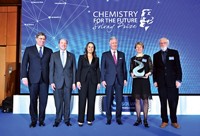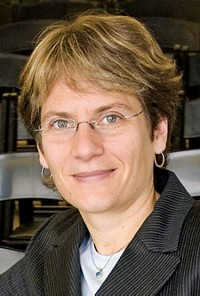Advertisement
Grab your lab coat. Let's get started
Welcome!
Welcome!
Create an account below to get 6 C&EN articles per month, receive newsletters and more - all free.
It seems this is your first time logging in online. Please enter the following information to continue.
As an ACS member you automatically get access to this site. All we need is few more details to create your reading experience.
Not you? Sign in with a different account.
Not you? Sign in with a different account.
ERROR 1
ERROR 1
ERROR 2
ERROR 2
ERROR 2
ERROR 2
ERROR 2
Password and Confirm password must match.
If you have an ACS member number, please enter it here so we can link this account to your membership. (optional)
ERROR 2
ACS values your privacy. By submitting your information, you are gaining access to C&EN and subscribing to our weekly newsletter. We use the information you provide to make your reading experience better, and we will never sell your data to third party members.
Environment
And The Winners Are: President Barack Obama Awards National Medals To 19 Individuals, One Team, And One Company
by Susan R. Morrissey
February 11, 2013
| A version of this story appeared in
Volume 91, Issue 6
At a White House ceremony on Feb. 1, President Barack Obama awarded 12 National Medals of Science to individuals for outstanding contributions to the knowledge of the biological, engineering, mathematical, physical, or social and behavioral sciences. He also bestowed nine National Medals of Technology & Innovation on seven individuals, a team, and a company for outstanding contributions to the nation’s economic, environmental, and social well-being through the development and commercialization of technology.
Following are the winners and the citations.
2011 National Medal of Science Laureates
Allen J. Bard, the Norman Hackerman-Welch Regents Chair in Chemistry at the University of Texas, Austin, for contributions in electrochemistry, including electroluminescence, semiconductor photoelectrochemistry, electroanalytical chemistry, and the invention of the scanning electrochemical microscope.
Sallie W. (Penny) Chisholm, the Lee & Geraldine Martin Professor of Environmental Studies at Massachusetts Institute of Technology, for contributions to the discovery and understanding of the dominant photosynthetic organisms in the ocean, promotion of the field of microbial oceanography, and influence on marine policy and management.
Sidney D. Drell, a senior fellow at the Hoover Institution and professor emeritus of theoretical physics at the SLAC National Accelerator Laboratory, Stanford University, for contributions to quantum field theory and quantum chromodynamics, application of science to inform national policies in security and intelligence, and distinguished contributions as an adviser to the U.S. government.
Sandra M. Faber, a University Professor of Astronomy & Astrophysics at the University of California, Santa Cruz, for leadership in numerous pathbreaking studies of extragalactic astronomy and galaxy formation and for oversight of the construction of important instruments, including the Keck telescopes.
Sylvester James Gates Jr., John S. Toll Professor and director of the Center for String & Particle Theory at the University of Maryland, for contributions to the mathematics of supersymmetry in particle, field, and string theories and extraordinary efforts to engage the public on the beauty and wonder of fundamental physics.
Solomon W. Golomb, the Andrew & Erna Viterbi Professor of Communications at the University of Southern California, for pioneering work in shift register sequences that changed the course of communications from analog to digital, and for numerous innovations in reliable and secure space, radar, cellular, wireless, and spread-spectrum communications.
John B. Goodenough, the Virginia H. Cockrell Centennial Chair in Engineering at the University of Texas, Austin, for groundbreaking cathode research that led to the first commercial lithium-ion battery, which has since revolutionized consumer electronics with technical applications for portable and stationary power.
M. Frederick Hawthorne, director of the International Institute of Nano & Molecular Medicine at the University of Missouri, for highly creative pioneering research in inorganic, organometallic, and medicinal borane chemistry; sustained and profound contributions to scientific and technical advice related to national security; and for effective, prolific, and devoted service to the broad field of chemical sciences.
Leroy Hood, president of the Institute for Systems Biology, for pioneering spirit, passion, vision, inventions, and leadership combined with unique cross-disciplinary approaches resulting in entrepreneurial ventures, transformative commercial products, and several new scientific disciplines that have challenged and transformed the fields of biotechnology, genomics, proteomics, personalized medicine, and science education.
Barry C. Mazur, the Gerhard Gade University Professor of Mathematics at Harvard University, for original and landmark contributions to differential topology, number theory, and arithmetic algebraic geometry, where, among other applications, his work was fundamental to Wiles’s proof of Fermat’s Last Theorem and for his dedication to communicating subtle mathematical ideas to the broader public.
Lucy Shapiro, a professor of developmental biology at Stanford University School of Medicine, for the pioneering discovery that the bacterial cell is controlled by an integrated genetic circuit functioning in time and space that serves as a systems engineering paradigm underlying cell differentiation and ultimately the generation of diversity in all organisms.
Anne M. Treisman, a professor of psychology at Princeton University, for a 50-year career of penetrating originality and depth that has led to the understanding of fundamental attentional limits in the human mind and brain.
2011 National Medal of Technology & Innovation Laureates
Frances H. Arnold, the Dick & Barbara Dickinson Professor of Chemical Engineering, Bioengineering & Biochemistry at California Institute of Technology, for pioneering research on biofuels and chemicals that could lead to the replacement of pollution-generating materials.
George R. Carruthers, a scientist in the space science division of the Naval Research Laboratory, for invention of the far-UV electrographic camera, which significantly improved our understanding of space and earth science.
Robert S. Langer, the David H. Koch Institute Professor at Massachusetts Institute of Technology, for inventions and discoveries that led to the development of controlled drug release systems, engineered tissues, angiogenesis inhibitors, and new biomaterials.
Norman R. McCombs, senior vice president of R&D at AirSep Corp., for the development and commercialization of pressure-swing adsorption oxygen-supply systems with a wide range of medical and industrial applications that have led to improved health and substantially reduced health care costs.
Gholam A. Peyman, a professor of optical sciences at the University of Arizona College of Medicine and Arizona Retinal Specialists, for invention of the LASIK surgical technique and for developing the field of intraocular drug administration and expanding the field of retinal surgery.
Arthur H. Rosenfeld, cofounder of the American Council for an Energy-Efficient Economy and California Institute for Energy & Environment, for extraordinary leadership in the development of energy-efficient building technologies and related standards and policies.
Jan T. Vilcek, a professor of microbiology at New York University School of Medicine, for pioneering work on interferons and key contributions to the development of therapeutic monoclonal antibodies.
Samuel Blum, Rangaswamy Srinivasan, and James Wynne of the IBM Thomas J. Watson Research Center for the pioneering discovery of excimer laser ablative photodecomposition of human and animal tissue, laying the foundation for PRK and LASIK, laser refractive surgical techniques that have revolutionized vision enhancement.
Raytheon BBN Technologies, in Cambridge, Mass., for sustained innovation through the engineering of first-of-a-kind, practical systems in acoustics, signal processing, and information technology.




Join the conversation
Contact the reporter
Submit a Letter to the Editor for publication
Engage with us on Twitter